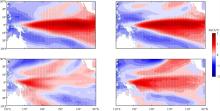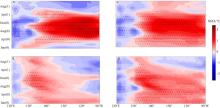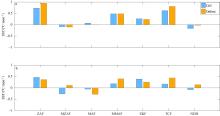| [1] |
ASHOK K, BEHERA S K, RAO S A, et al, 2007. El Niño Modoki and its possible teleconnection[J]. Journal of Geophysical Research, 112(C11): C11007.
doi: 10.1029/2006JC003798
|
| [2] |
BJERKNES J, 1969. Atmospheric teleconnections from the equatorial Pacific[J]. Monthly Weather Review, 97(3): 163-172.
doi: 10.1175/1520-0493(1969)097<0163:ATFTEP>2.3.CO;2
|
| [3] |
BURGERS G, STEPHENSON D B, 1999. The “normality” of El Niño[J]. Geophysical Research Letters, 26(8): 1027-1030.
doi: 10.1029/1999GL900161
|
| [4] |
CHANG PING, ZHANG LI, SARAVANAN R, et al, 2007. Pacific meridional mode and El Niño-Southern oscillation[J]. Geophysical Research Letters, 34(16): L16608.
|
| [5] |
CHEN DAKE, LIAN TAO, FU CONGBIN, et al, 2015. Strong influence of westerly wind bursts on El Niño diversity[J]. Nature Geoscience, 8(5): 339-345.
doi: 10.1038/ngeo2399
|
| [6] |
FANG S W, YU JINYI, 2020. A control of ENSO transition complexity by tropical Pacific mean SSTs through tropical-subtropical interaction[J]. Geophysical Research Letters, 47(12): e2020GL087933.
|
| [7] |
FENG JIE, LIAN TAO, 2018. Assessing the relationship between MJO and equatorial pacific WWBs in observations and CMIP5 models[J]. Journal of Climate, 31(16): 6393-6410.
doi: 10.1175/JCLI-D-17-0526.1
|
| [8] |
FENG JIE, LIAN TAO, YING JUN, et al, 2020. Do CMIP5 models show El Niño diversity?[J]. Journal of Climate, 33(5): 1619-1641.
doi: 10.1175/JCLI-D-18-0854.1
|
| [9] |
Galanti E, Tziperman E, 2000. ENSO’s phase locking to the seasonal cycle in the fast-SST, fast-wave, and mixed-mode regimes[J]. Journal of the atmospheric sciences, 57(17), 2936-2950.
doi: 10.1175/1520-0469(2000)057<2936:ESPLTT>2.0.CO;2
|
| [10] |
HARRISON D E, VECCHI G A, 1997. Westerly wind events in the tropical pacific, 1986-95[J]. Journal of Climate, 10(12): 3131-3156.
doi: 10.1175/1520-0442(1997)010<3131:WWEITT>2.0.CO;2
|
| [11] |
JIN FEIFEI, 1997. An equatorial ocean recharge paradigm for ENSO. Part I: Conceptual model[J]. Journal of the Atmospheric Sciences, 54(7): 811-829.
doi: 10.1175/1520-0469(1997)054<0811:AEORPF>2.0.CO;2
|
| [12] |
KANG I S, KUG J S, 2000. An El-Niño Prediction system using an intermediate ocean and a statistical atmosphere[J]. Geophysical Research Letters, 27(8): 1167-1170.
doi: 10.1029/1999GL011023
|
| [13] |
KAO H Y, YU JINYI, 2009. Contrasting eastern-Pacific and central-Pacific types of ENSO[J]. Journal of Climate, 22(3): 615-632.
doi: 10.1175/2008JCLI2309.1
|
| [14] |
KUG J S, JIN FEIFEI, AN S I, 2009. Two types of El Niño events: cold tongue El Niño and warm pool El Niño[J]. Journal of Climate, 22(6): 1499-1515.
doi: 10.1175/2008JCLI2624.1
|
| [15] |
LIAN TAO, CHEN DAKE, TANG YOUMIN, et al, 2018. Linkage between westerly wind bursts and tropical cyclones[J]. Geophysical Research Letters, 45(20): 11431-11438.
|
| [16] |
LIAN TAO, YING JUN, REN HONGLI, et al, 2019. Effects of tropical cyclones on ENSO[J]. Journal of Climate, 32(19): 6423-6443.
doi: 10.1175/JCLI-D-18-0821.1
|
| [17] |
LIAN TAO, CHEN DAKE, 2021. The essential role of early-spring westerly wind bursts in generating the centennial extreme 1997/98 El Niño[J]. Journal of Climate, 34(20): 8377-8388.
|
| [18] |
MCPHADEN M J, FREITAG H P, HAYES S P, et al, 1988. The response of the equatorial Pacific Ocean to a westerly wind burst in May 1986[J]. Journal of Geophysical Research, 93(C9): 10589-10603.
doi: 10.1029/JC093iC09p10589
|
| [19] |
OHBA M, UEDA H, 2009. Role of nonlinear atmospheric response to SST on the asymmetric transition process of ENSO[J]. Journal of Climate, 22(1): 177-192.
doi: 10.1175/2008JCLI2334.1
|
| [20] |
RASMUSSON E M, WALLACE J M, 1983. Meteorological aspects of the El Niño/Southern oscillation[J]. Science, 222(4629): 1195-1202.
doi: 10.1126/science.222.4629.1195
|
| [21] |
REN HONGLI, JIN FEIFEI, 2013. Recharge oscillator mechanisms in two types of ENSO[J]. Journal of Climate, 26(17): 6506-6523.
doi: 10.1175/JCLI-D-12-00601.1
|
| [22] |
SCHOPF P S, SUAREZ M J, 1988. Vacillations in a coupled ocean-atmosphere model[J]. Journal of the Atmospheric Sciences, 45(3): 549-566.
doi: 10.1175/1520-0469(1988)045<0549:VIACOM>2.0.CO;2
|
| [23] |
SOBEL A H, CAMARGO S J, 2005. Influence of western North Pacific tropical cyclones on their Large-Scale environment[J]. Journal of the Atmospheric Sciences, 62(9): 3396-3407.
doi: 10.1175/JAS3539.1
|
| [24] |
SYU H H, NEELIN J D, 2000. ENSO in a hybrid coupled model. Part I: sensitivity to physical parametrizations[J]. Climate Dynamics, 16(1): 19-34.
doi: 10.1007/PL00007920
|
| [25] |
TAKAHASHI K, MONTECINOS A, GOUBANOVA K, et al, 2011. ENSO regimes: Reinterpreting the canonical and Modoki El Niño[J]. Geophysical Research Letters, 38(10): L10704.
|
| [26] |
TAN XIAOXIAO, TANG YOUMIN, LIAN TAO, et al, 2020. A study of the effects of westerly wind bursts on ENSO based on CESM[J]. Climate Dynamics, 54(1): 885-899.
doi: 10.1007/s00382-019-05034-2
|
| [27] |
VERTENSTEIN M, CRAIG T, MIDDLETON A, et al, 2012. CESM1. 0. 4 user’s guide. NCAR. https://www.cesm.ucar.edu/models/cesm1.0/cesm/cesm_doc_1_0_4/c31.html
|
| [28] |
WANG QIUYUN, LI JIANPING, JIN FEIFEI, et al, 2019. Tropical cyclones act to intensify El Niño[J]. Nature Communications, 10(1): 3793.
doi: 10.1038/s41467-019-11720-w
pmid: 31439837
|
| [29] |
WOLTER K, TIMLIN M S, 2011. El Niño/Southern oscillation behaviour since 1871 as diagnosed in an extended multivariate ENSO index (MEI.ext)[J]. International Journal of Climatology, 31(1): 1074-1087.
doi: 10.1002/joc.2336
|
| [30] |
YU JINYI, KAO H Y, LEE T, 2010. Subtropics-related interannual sea surface temperature variability in the central equatorial Pacific[J]. Journal of Climate, 23(11): 2869-2884.
doi: 10.1175/2010JCLI3171.1
|
| [31] |
YU JINYI, FANG S W, 2018. The distinct contributions of the seasonal footprinting and charged-discharged mechanisms to ENSO complexity[J]. Geophysical Research Letters, 45(13): 6611-6618.
doi: 10.1029/2018GL077664
|
| [32] |
YU LISAN, WELLER R A, LIU W T, 2003. Case analysis of a role of ENSO in regulating the generation of westerly wind bursts in the Western Equatorial Pacific[J]. Journal of Geophysical Research, 108(C4): 3128.
doi: 10.1029/2002JC001498
|
















